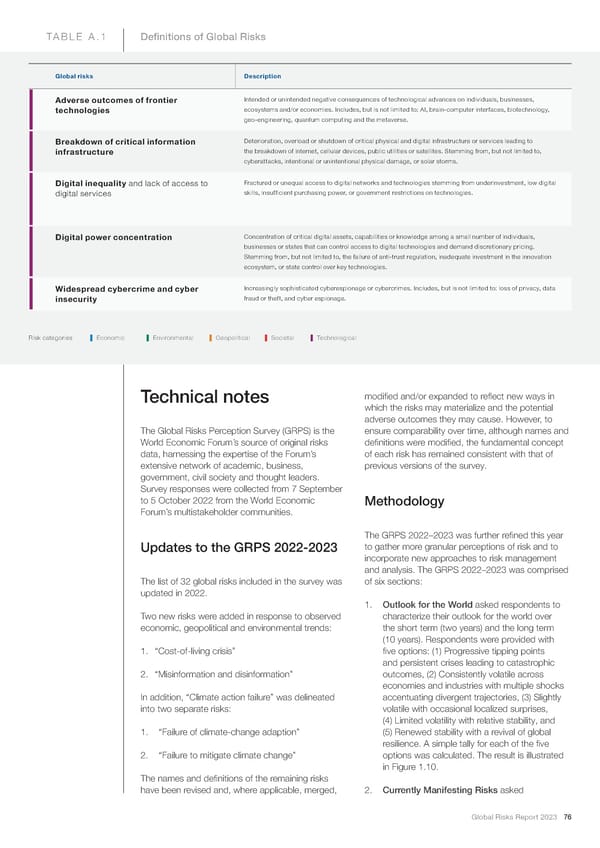TABLE A.1 De昀椀nitions of Global Risks Global risks Description Adverse outcomes of frontier Intended or unintended negative consequences of technological advances on individuals, businesses, technologies ecosystems and/or economies. Includes, but is not limited to: AI, brain-computer interfaces, biotechnology, geo-engineering, quantum computing and the metaverse. Breakdown of critical information Deterioration, overload or shutdown of critical physical and digital infrastructure or services leading to infrastructure the breakdown of internet, cellular devices, public utilities or satellites. Stemming from, but not limited to, cyberattacks, intentional or unintentional physical damage, or solar storms. Digital inequality and lack of access to Fractured or unequal access to digital networks and technologies stemming from underinvestment, low digital digital services skills, insufficient purchasing power, or government restrictions on technologies. Digital power concentration Concentration of critical digital assets, capabilities or knowledge among a small number of individuals, businesses or states that can control access to digital technologies and demand discretionary pricing. Stemming from, but not limited to, the failure of anti-trust regulation, inadequate investment in the innovation ecosystem, or state control over key technologies. Widespread cybercrime and cyber Increasingly sophisticated cyberespionage or cybercrimes. Includes, but is not limited to: loss of privacy, data insecurity fraud or theft, and cyber espionage. Risk categories Economic Environmental Geopolitical Societal Technological Technical notes modi昀椀ed and/or expanded to re昀氀ect new ways in which the risks may materialize and the potential adverse outcomes they may cause. However, to The Global Risks Perception Survey (GRPS) is the ensure comparability over time, although names and World Economic Forum’s source of original risks de昀椀nitions were modi昀椀ed, the fundamental concept data, harnessing the expertise of the Forum’s of each risk has remained consistent with that of extensive network of academic, business, previous versions of the survey. government, civil society and thought leaders. Survey responses were collected from 7 September to 5 October 2022 from the World Economic Methodology Forum’s multistakeholder communities. The GRPS 2022–2023 was further re昀椀ned this year Updates to the GRPS 2022-2023 to gather more granular perceptions of risk and to incorporate new approaches to risk management and analysis. The GRPS 2022–2023 was comprised The list of 32 global risks included in the survey was of six sections: updated in 2022. 1. Outlook for the World asked respondents to Two new risks were added in response to observed characterize their outlook for the world over economic, geopolitical and environmental trends: the short term (two years) and the long term (10 years). Respondents were provided with 1. “Cost-of-living crisis” 昀椀ve options: (1) Progressive tipping points and persistent crises leading to catastrophic 2. “Misinformation and disinformation” outcomes, (2) Consistently volatile across economies and industries with multiple shocks In addition, “Climate action failure” was delineated accentuating divergent trajectories, (3) Slightly into two separate risks: volatile with occasional localized surprises, (4) Limited volatility with relative stability, and 1. “Failure of climate-change adaption” (5) Renewed stability with a revival of global resilience. A simple tally for each of the 昀椀ve 2. “Failure to mitigate climate change” options was calculated. The result is illustrated in Figure 1.10. The names and de昀椀nitions of the remaining risks have been revised and, where applicable, merged, 2. Currently Manifesting Risks asked Global Risks Report 2023 76
 Global Risks Report 2023 Page 75 Page 77
Global Risks Report 2023 Page 75 Page 77